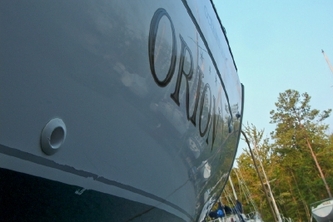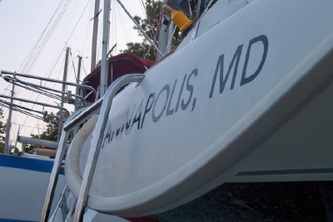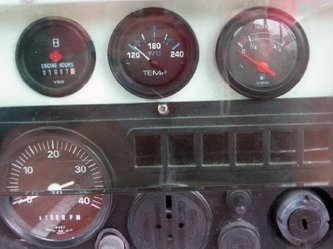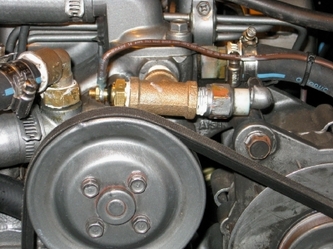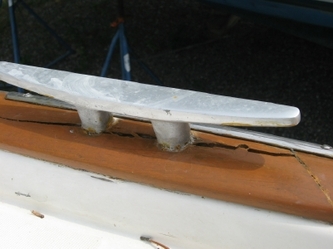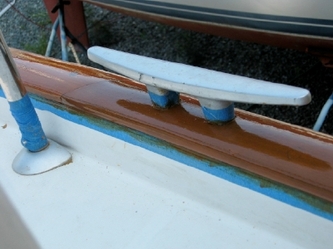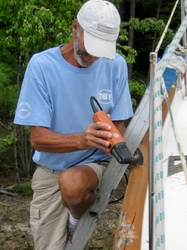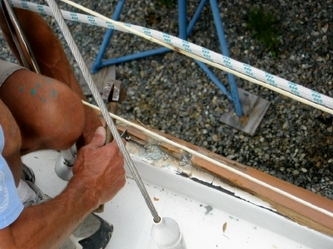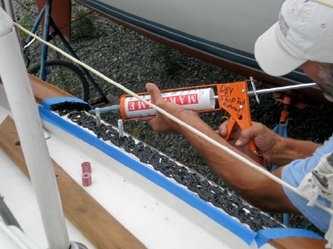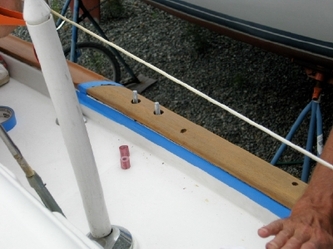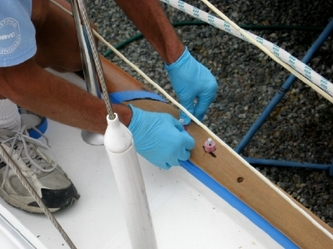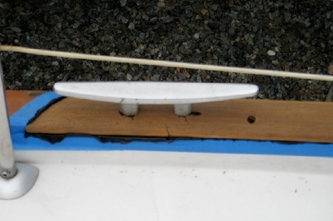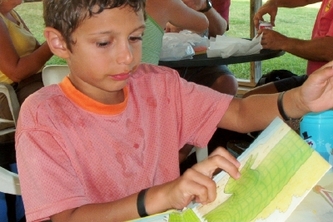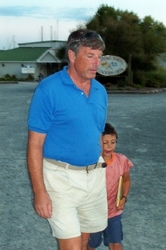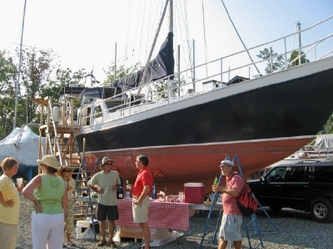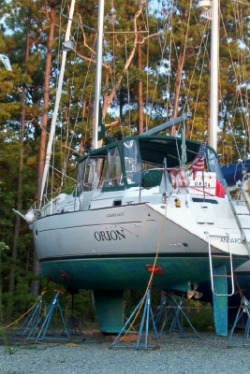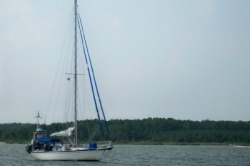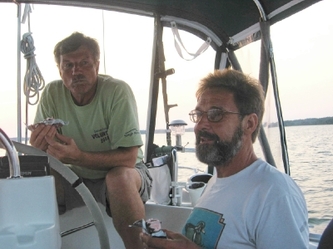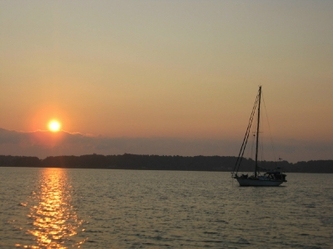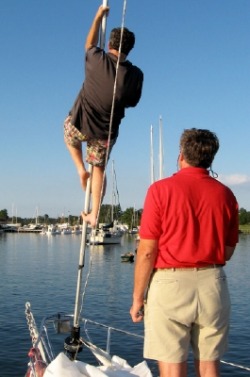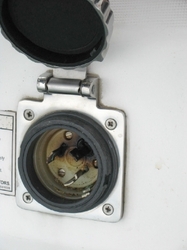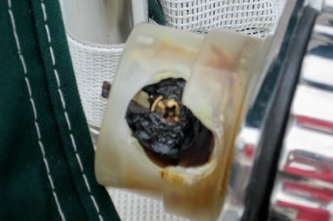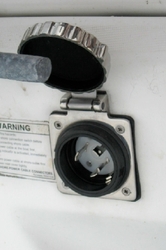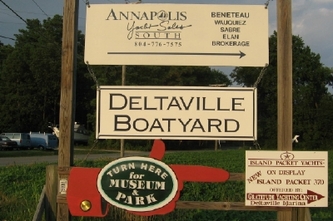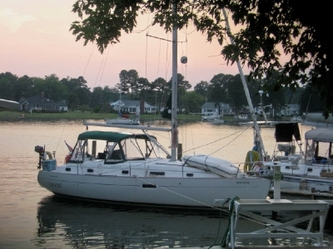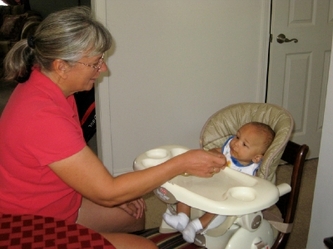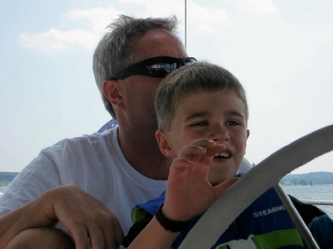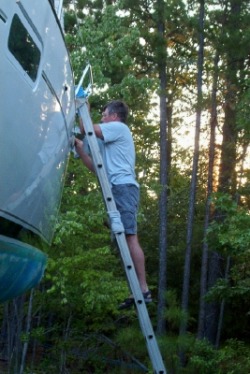
No sailing stories. No tales of weathering terrific storms or making a great run from here to there. No exotic ports. There will be none of that in this update. For good or bad, we’ve settled into life on the hard, with all its plusses (such as getting access to parts of the boat that are normally inaccessible) and minuses (such as the quarter mile walk (run) to the restrooms and the lack of A/C). At least it’s keeping us in good shape.
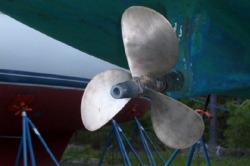
Bright and shiny prop after cleaning
With Orion’s bottom now staring us in the face every day, we had time and access to prepare her for re-painting and re-entry to the water. Dave took a wire wheel to the prop to make it shine like new. He later learned that wrapping the prop and drive shaft in vinegar-soaked cloths can have a similar effect. So, he used this method to good effect to clean the remaining nooks and crannies.
Of course, the main reason we hauled the boat was to have the bottom painted, but there was only a limited amount of work on this that could be done now. Having already scraped the bottom to remove the barnacles and greased the thru-hulls, the one thing that we could do was to purchase the bottom paint. Dave used a price match at West Marine to save quite a bit on the 2 gallons that the boatyard will require. The remaining bottom prep and painting will be done by the boatyard. Since the hard paint we use requires a limited (< 30 days) exposure to the air to maintain its effectiveness as an anti-fouling barrier, we need to have the work done in late September, just before our return to the Chesapeake with Marianna. Having the boatyard do this while we are traveling will ensure she is ready to launch soon after we return.
Shine On
Of course, the main reason we hauled the boat was to have the bottom painted, but there was only a limited amount of work on this that could be done now. Having already scraped the bottom to remove the barnacles and greased the thru-hulls, the one thing that we could do was to purchase the bottom paint. Dave used a price match at West Marine to save quite a bit on the 2 gallons that the boatyard will require. The remaining bottom prep and painting will be done by the boatyard. Since the hard paint we use requires a limited (< 30 days) exposure to the air to maintain its effectiveness as an anti-fouling barrier, we need to have the work done in late September, just before our return to the Chesapeake with Marianna. Having the boatyard do this while we are traveling will ensure she is ready to launch soon after we return.
Shine On
With the upper hull stripped clean of any stains and (therefore) wax, we proceeded to re-apply wax to her hull. First, we used a cleaning wax to remove any black marks that the hull cleaner didn’t take care of (from perhaps getting a little too close to some fixed objects). This was followed with a 2nd coat of a polishing wax to really make her shine – at least for a while.
Cathy also spent several days applying fresh coats of Cetol to the remaining teak that had not been done this year – the cockpit seats and handrails, the swim platform and the hatch boards. The more we stay on top of it, the less work it is and the better it looks.
Temperature’s Rising
Cathy also spent several days applying fresh coats of Cetol to the remaining teak that had not been done this year – the cockpit seats and handrails, the swim platform and the hatch boards. The more we stay on top of it, the less work it is and the better it looks.
Temperature’s Rising
When our raw water strainer was losing water with almost every run, Dave was concerned that this might cause the engine to overheat. However, with no gauge to tell him the engine temperature, it was difficult to know for sure how the engine was reacting. Although we believe the raw water strainer problem is fixed, it became the motivation for getting more on-going diagnostic information about the engine.
After discussions with John, the engine mechanic here at Deltaville, Dave decided to install a temperature gauge. To keep costs down, he ran the wiring from the engine room to the instrument panel. Then John returned with Nick to install the temperature gauge and sender. Taking care to keep air out of the line, Nick replaced the original sender (which triggered an alarm) with the new one, which will provide the data for the gauge as well as an alarm. This was wired into the newly-mounted gauge on the instrument panel. It was installed so that it will light up at night with our other fuel and rpm gauges, which should make it easily visible from the helm. The system will need to be bled once we are back in the water, when we can test it as well. Assuming it works as expected, it should make it easier to know if the engine is running fine or at risk of overheating. This way we can take some action to avoid damaging the engine before it gets too hot.
Cracking Up
After discussions with John, the engine mechanic here at Deltaville, Dave decided to install a temperature gauge. To keep costs down, he ran the wiring from the engine room to the instrument panel. Then John returned with Nick to install the temperature gauge and sender. Taking care to keep air out of the line, Nick replaced the original sender (which triggered an alarm) with the new one, which will provide the data for the gauge as well as an alarm. This was wired into the newly-mounted gauge on the instrument panel. It was installed so that it will light up at night with our other fuel and rpm gauges, which should make it easily visible from the helm. The system will need to be bled once we are back in the water, when we can test it as well. Assuming it works as expected, it should make it easier to know if the engine is running fine or at risk of overheating. This way we can take some action to avoid damaging the engine before it gets too hot.
Cracking Up
We have been very pleased with the design and durability of our Beneteau 36cc. It takes our daily use well and still looks great – for the most part. One notable exception is the wood under the midship and bow cleats, which has been splitting a little more every year since we bought her. When we discussed this with Matt in Deltaville Boatyard office, he immediately described the problem and the reason for it. The stainless steel cleat was run through an aluminum sleeve within the teak toerail. The combination of dissimilar metals and a saltwater environment led to corrosion and expansion of the joint, thus splitting the teak around it. The boatyard had repaired several of these and knew exactly what would be required to fix our cleats. The aluminum sleeve would be replaced with a stainless steel insert and that would eliminate the corrosion. Then the teak around the cleat would be removed and replaced.
Since we had attempted to have this repaired once before, only to see it split again, we were reluctant to attack all of the problem cleats at once. Instead, we decided to address the worst one and see if the repair held. If so (and if we could afford it), we could have the others repaired or maybe do it ourselves.
To give access to the underside of the cleat so that it could be removed, we removed part of the port cabinet in the main saloon. Dallas, a boatyard worker and one of our neighbors here on the hard, removed the cleat, with quite a bit of effort. Once it was removed, he discovered that the aluminum sleeve was effectively welded onto the cleat and couldn’t be removed. Therefore, he had to fabricate a fiberglass-reinforced plastic (FRP) bushing to surround the cleat as it passed through the teak. This would absorb any expansion and keep the wood intact.
Since we had attempted to have this repaired once before, only to see it split again, we were reluctant to attack all of the problem cleats at once. Instead, we decided to address the worst one and see if the repair held. If so (and if we could afford it), we could have the others repaired or maybe do it ourselves.
To give access to the underside of the cleat so that it could be removed, we removed part of the port cabinet in the main saloon. Dallas, a boatyard worker and one of our neighbors here on the hard, removed the cleat, with quite a bit of effort. Once it was removed, he discovered that the aluminum sleeve was effectively welded onto the cleat and couldn’t be removed. Therefore, he had to fabricate a fiberglass-reinforced plastic (FRP) bushing to surround the cleat as it passed through the teak. This would absorb any expansion and keep the wood intact.
Now the existing teak had to be removed and the fiberglass underneath cleaned to make a smooth bed to lay the new piece of teak. An existing seam in the wood only a few inches aft of the cleat would mark one end of the section to be removed, but the foreward end would require a new angled cut (to match the existing seams) about 2 feet foreward of the cleat. Dallas then chiseled the resulting section of toerail to remove it from the hull. The boatyard already had in its shop wood milled to match the 36cc toerail, so fitting the new piece was a matter of creating a template to match the angled cuts on either end and aligning the holes for the cleat placement.
Once the piece was cut to match the template, it was fitted into the opening, glued in place with a marine epoxy, the cleat re-installed with the FRP bushing and allowed to dry overnight. The next day, Dallas put teak plugs over the screws which attached the section to the deck. After sanding the new section flush with the existing wood, he left it for us to re-finish (another cost-saving effort). The results look pleasing. Hopefully, the repair will stand the test of time.
Survey
Upon finding ourselves on the hard for several weeks, we made a list of the things we should try to get done while we were out of the water. One of these things was to have a survey done, which for you landlubbers out there is like a home inspection for the boat. In the process of looking for insurance that will allow us to travel further into the Bahamas, some companies would require a survey before writing a policy. Since most surveys require a haul-out to be done, being on the hard already would significantly reduce this expense.
Talking to the Boatyard and the Annapolis Yacht Sales representative here in Deltaville, we quickly settled on Don McCann from Tranquil Waters Marine Survey. In preparation, we tidied up the boat, but generally did little other prep work. For almost 3 hours, he reviewed the inside and outside, top and bottom of Orion. When we received his report the next week, we were delighted to find no “recommendations” for fixes that would need to be done to ensure her safety. This should make it easier to get insurance based on the resulting survey.
He did identify some considerations for improving certain systems on Orion that we are looking into -- such as a higher capacity emergency bilge pump and a high water alarm.
Survey
Upon finding ourselves on the hard for several weeks, we made a list of the things we should try to get done while we were out of the water. One of these things was to have a survey done, which for you landlubbers out there is like a home inspection for the boat. In the process of looking for insurance that will allow us to travel further into the Bahamas, some companies would require a survey before writing a policy. Since most surveys require a haul-out to be done, being on the hard already would significantly reduce this expense.
Talking to the Boatyard and the Annapolis Yacht Sales representative here in Deltaville, we quickly settled on Don McCann from Tranquil Waters Marine Survey. In preparation, we tidied up the boat, but generally did little other prep work. For almost 3 hours, he reviewed the inside and outside, top and bottom of Orion. When we received his report the next week, we were delighted to find no “recommendations” for fixes that would need to be done to ensure her safety. This should make it easier to get insurance based on the resulting survey.
He did identify some considerations for improving certain systems on Orion that we are looking into -- such as a higher capacity emergency bilge pump and a high water alarm.

A Visiting Crewmember
When we invited our grandson for a visit, we expected to be in the water in Hampton, where we could take some day sails and explore the Hampton Roads area from a 6 year-old’s perspective. When it became clear we were instead going to be on the hard 10 feet up in the air, we ran it by his dad to see if there were any concerns. No. He should love it.
We arrived back at the boat late on a Saturday, and Droz was up the ladder in no time. So much for any concerns about fear of heights. Within minutes we were off to the pool, which became the hit attraction for the week. Droz even claimed that when he woke up in the morning, he could swear we were on the water.
Maybe for a 6-year-old, imagination is everything.
When we invited our grandson for a visit, we expected to be in the water in Hampton, where we could take some day sails and explore the Hampton Roads area from a 6 year-old’s perspective. When it became clear we were instead going to be on the hard 10 feet up in the air, we ran it by his dad to see if there were any concerns. No. He should love it.
We arrived back at the boat late on a Saturday, and Droz was up the ladder in no time. So much for any concerns about fear of heights. Within minutes we were off to the pool, which became the hit attraction for the week. Droz even claimed that when he woke up in the morning, he could swear we were on the water.
Maybe for a 6-year-old, imagination is everything.
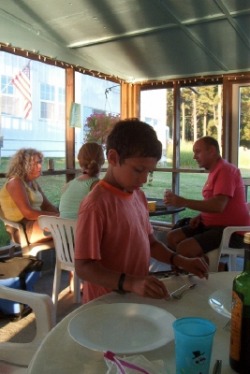
Droz sets the table in the screened porch
Cruising Connections
Given what the Chesapeake usually dishes out in late summer, it’s been an amazingly cool August, with temperatures more in the 80’s than 90’s during the day and generally in the 60’s at night. We couldn’t ask for much better.
That being said, with the late August heat and humidity causing the cabin temperature to soar in the afternoons, fixing dinner on board was very unappealing. So, to avoid a mutiny, we moved our dining to the breezy screened porch at the end of the covered boat dock, complete with grill, tables, chairs and – most important -- company from other cruisers in the boatyard. This nightly ritual became the time to catch up on each other’s projects, solicit advice, learn each other’s stories and just laugh and relax as we caught a cool breeze from the water. By the time we returned to the boat, the evening air was usually cool and the boat quickly cooled to a fine sleeping temperature.
Much better than sweating it out back on Orion.
With our sudden departure from Joy’s Marina in Hampton, we missed saying goodbye to Steve and Christa on Bay Dreamer and we were days away from welcoming Tom and Cathie on Interlude, who took up residence just after we left. So, we made a day trip back to Hampton to pick up the car and, luckily, met up with Tom and Cathie and Steve on the dock. We said our goodbyes for now, with hopes to see them again this fall. (We thought we had one more opportunity to see Steve over Labor Day when his Fleet 30 group was planning a trip to Deltaville. Although Steve couldn’t make it, we did meet many of the group, who had several events, including guitar music by the pool and a big potluck on Sunday night that we were invited to share.)
Appeasing the God of the Sea
Given what the Chesapeake usually dishes out in late summer, it’s been an amazingly cool August, with temperatures more in the 80’s than 90’s during the day and generally in the 60’s at night. We couldn’t ask for much better.
That being said, with the late August heat and humidity causing the cabin temperature to soar in the afternoons, fixing dinner on board was very unappealing. So, to avoid a mutiny, we moved our dining to the breezy screened porch at the end of the covered boat dock, complete with grill, tables, chairs and – most important -- company from other cruisers in the boatyard. This nightly ritual became the time to catch up on each other’s projects, solicit advice, learn each other’s stories and just laugh and relax as we caught a cool breeze from the water. By the time we returned to the boat, the evening air was usually cool and the boat quickly cooled to a fine sleeping temperature.
Much better than sweating it out back on Orion.
With our sudden departure from Joy’s Marina in Hampton, we missed saying goodbye to Steve and Christa on Bay Dreamer and we were days away from welcoming Tom and Cathie on Interlude, who took up residence just after we left. So, we made a day trip back to Hampton to pick up the car and, luckily, met up with Tom and Cathie and Steve on the dock. We said our goodbyes for now, with hopes to see them again this fall. (We thought we had one more opportunity to see Steve over Labor Day when his Fleet 30 group was planning a trip to Deltaville. Although Steve couldn’t make it, we did meet many of the group, who had several events, including guitar music by the pool and a big potluck on Sunday night that we were invited to share.)
Appeasing the God of the Sea
Historically, sailors could be a superstitious lot. With so much of their fortunes at the whim of Mother Nature and the sea god, Neptune, it’s not surprising that they were quick to latch onto anything that might rile them. One thing that was sure to have serious consequences in bad luck was trying to rename a vessel, which might bring the wrath of Neptune on them in a fury. To ward this off, it was necessary that a proper re-naming include a ceremony to appease the god of the sea, usually involving lots of “libations”.
We were honored to participate in such a ceremony for some neighbors of ours – Chris and Leigh. They wanted to replace the previous appellation, Gigolo, with the new one, Namiste (referring to a Yoga position of peace and tranquility, I think). After carefully removing any reference to the former name (per the proscribed ritual) and before loading any reference to the new name, the ceremony was held at sunset on the Friday of Labor Day weekend. Neptune was given his due with words and, of course, libations, and Gigolo was a thing of the past.
Surely good luck will now follow as newly re-named Namistad prepares for her splash down and journeys south.
Summer’s End
As Labor Day comes and goes, we prepare to leave Deltaville and head north to New Hampshire, where we’ll spend time visiting and then heading south as crew on Marianna. By the time we return, maybe the days will have cooled off some, and the boat projects will be largely behind us, ready for our return to the water – and some more of those sailing stories we’ve been so long in telling.
We were honored to participate in such a ceremony for some neighbors of ours – Chris and Leigh. They wanted to replace the previous appellation, Gigolo, with the new one, Namiste (referring to a Yoga position of peace and tranquility, I think). After carefully removing any reference to the former name (per the proscribed ritual) and before loading any reference to the new name, the ceremony was held at sunset on the Friday of Labor Day weekend. Neptune was given his due with words and, of course, libations, and Gigolo was a thing of the past.
Surely good luck will now follow as newly re-named Namistad prepares for her splash down and journeys south.
Summer’s End
As Labor Day comes and goes, we prepare to leave Deltaville and head north to New Hampshire, where we’ll spend time visiting and then heading south as crew on Marianna. By the time we return, maybe the days will have cooled off some, and the boat projects will be largely behind us, ready for our return to the water – and some more of those sailing stories we’ve been so long in telling.
